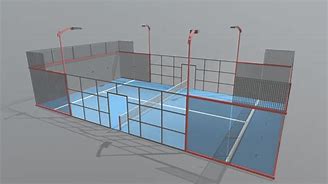

The Cost of Padel Tennis Courts in China A Comprehensive Overview
Padel tennis, a dynamic racquet sport that combines elements of tennis and squash, has been rapidly gaining popularity across the globe, including in China. With the sport’s growth, enthusiasm extends beyond just playing; it includes building facilities that cater to budding players. For those interested in creating or investing in padel tennis courts, understanding the associated costs is crucial. This article provides an in-depth look at the various factors influencing the overall cost of padel tennis courts in China.
Initial Investment Court Construction Costs
The primary expenditure when establishing a padel tennis facility is the construction of the courts themselves. On average, constructing a standard padel court can range from 100,000 to 300,000 RMB ($15,000 to $45,000). The cost variation largely depends on several factors, including
1. Materials Used Padel courts can be built with different types of materials, such as glass, artificial turf, and concrete. High-quality materials will generally increase the initial investment but can enhance durability and player experience.
2. Court Dimensions A standard padel court measures 20 meters by 10 meters. However, customized sizes may incur additional costs. Building multiple courts can also lead to economies of scale, potentially reducing the price per court when constructing in bulk.
3. Location Urban areas often have higher land costs than rural regions. Additionally, local regulations and construction codes can affect the overall expense. It’s essential to conduct thorough research into the potential site before finalizing the investment.
Additional Operating Costs
Once the initial construction is completed, several ongoing operational costs must be considered
1. Maintenance Costs Regular maintenance ensures that the courts remain in excellent playing condition. This can include resurfacing, cleaning, and repairs, which could range from 1,000 to 5,000 RMB ($150 to $750) annually per court, depending on usage and weather conditions.
2. Staffing If you intend to operate a commercial facility, hiring staff will be necessary. This includes coaches, maintenance personnel, and administrative staff, which can amount to a significant monthly expense.
3. Utilities Electricity, water, and other utility costs should also be factored in. The price will vary depending on facility size, usage, and local rates.

Revenue Potential
Investing in padel tennis courts can provide substantial revenue opportunities. Facilities can generate income through various channels
1. Court Rentals Charging players for court time is a primary revenue stream. In China, hourly rental rates typically range from 100 to 300 RMB ($15 to $45), depending on location and amenities.
2. Coaching and Training Offering coaching services or training programs can attract both casual players and competitive athletes. This can bolster income significantly, especially if engaging well-known coaches.
3. Tournaments and Events Hosting tournaments and special events can draw participants and spectators, creating opportunities for sponsorship and partnerships with local businesses.
4. Membership Programs Establishing membership tiers can encourage regular play and provide a steady revenue flow. Offering perks such as discounts on court rentals and exclusive coaching sessions can make memberships appealing.
Long-term Considerations
Before investing in padel tennis courts, it’s crucial to conduct a thorough feasibility study. Analyzing market demand, competition, and potential player demographics will help gauge the success potential of a new facility.
In addition to the initial and ongoing costs, considering the return on investment (ROI) is essential. With the rise of padel tennis in China, the investment may yield fruitful returns in the long run, especially in urban areas with a growing interest in the sport.
Conclusion
The cost of building and operating padel tennis courts in China involves multiple factors, including construction materials, location, and ongoing operational expenses. However, with careful planning and strategic marketing, investing in this rapidly growing sport can be a lucrative venture. As more players flock to the courts, those who get in early may well reap the rewards of this burgeoning trend.
High-Performance Industrial Flooring Solutions China Paddle Tennis Court for Sale
High-Performance Industrial Flooring Solutions Durable & Cost-Effective
Homogeneous Transparent Floor – Durable & Stylish Rubber Floor Solutions
Premium Homogeneous Transparent Floor for Durable & Stylish Spaces Rubber Floor Solutions
Premium Sports Floor Solutions Durable PVC Sports Floor & Rubber Floor for Gyms
Durable Rubber Composite Floor Premium Rubber Floor & Mats Solutions